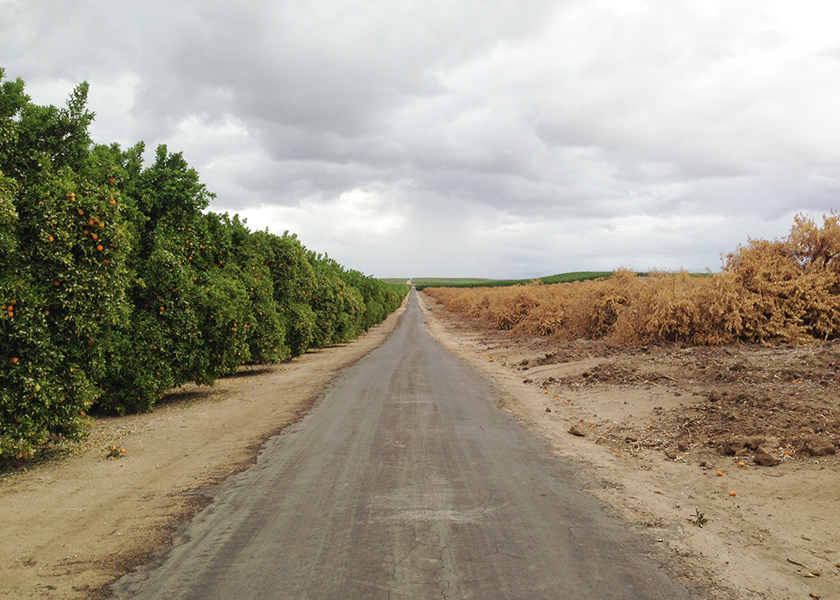Growers speak out on water crisis

California’s water crisis is bad and getting worse.
Bringing into focus some of the California crop losses caused by the 2021 drought, Western Growers has released a series of videos called “No Water = No Crops.”
The videos feature three California farmers who talk about the losses they are suffering this year.
“This is one of the most difficult decisions I’ve had to make in a long time,” Joe Del Bosque of Del Bosque Farms, Firebaugh, Calif., who sacrificed his asparagus field that still had five years’ productivity left, said in one video.
“Seventy people are going to lose their jobs here. Next year, there will be no harvest here. Those 70 people lose two months of work. It’s a very difficult hit for them.”
Another video features Ross Franson of Fresno, Calif.-based Woolf Farming.
“Around this time of year, we’d normally be prepping for harvest,” Franson said in the video.
The farm has started knocking down almond trees in its 400-acre orchard, he said.
“But due to the dire drought that’s going on in the state of California right now, we made the decision to pull these trees out simply because we didn’t have the water to irrigate them.”
“These trees are all dead, and they shouldn’t be,” Jared Plumlee of Booth Ranches said in one video.
The company produces citrus in Orange Cove, Calif., and destroyed 70 acres of trees because of the drought.
“It’s just a shame. This block had probably 20 years of productive life, and we were forced to push it out.”
Speaking to The Packer July 15, Plumlee said there is no doubt the drought and the state’s hydrology isn’t good now.
“I’m not trying to be a climate denier,” he said. “But I also understand that there probably is enough water to make ends meet and to supply everybody’s needs, if only it were managed properly. I think I think we need to focus on better management.”
Plumlee said more regulatory flexibility is needed to deal with California’s drought years.
Making water history
The water year that ended in July was the driest year on record in California, said Ian LeMay, president of the California Fresh Fruit Association, Fresno. The state has been collecting water data for more than 100 years.
LeMay said the historically dry year also is coupled with the beginning stages of implementation of the Sustainable Groundwater Management Act (SGMA), which was passed in 2014 to prevent overdraft of groundwater in California.
Though the law won’t fully be implemented until 2042, LeMay said growers are already working with groundwater sustainability programs to identify how much water they can take out of the underground aquifers.
“In traditional terms, when California growers have been presented with drought and have limited surface deliveries of water, we relied on that underground aquifer,” LeMay said. “That reliance isn’t there anymore, and that is forcing growers to make decisions.”
Some growers are pulling trees or vines out of production to direct whatever water is available to more premium crops. With tree fruit orchards and grape vineyards typically viable for 25-35 years, destroying production before its useful life is over is difficult, he said. Replanting may not take place if no water is available.
“It is an untenable situation, and no one wants to be in it.”
In his messages to lawmakers at the state and federal level, LeMay has told them that agriculture will be much diminished if growers aren’t given the resources to survive.
“They have to make a choice; do they want to have a long-term viable agriculture industry in California? Or do they want to see it take a diminished role?” LeMay said.
No one argues the merits of SGMA and a sustainable groundwater aquifer, but LeMay said lawmakers must help growers.
“The state can’t just pass a law like that and then step back and not help,” he said.
Significant investments in the state’s water infrastructure are needed, including above-ground storage, repairing canal infrastructure, enhancing water mobility in the state, and putting in place ways to put more water into aquifers in wet years.
“The Newsom administration and our elected officials really have to make a value assessment of how much they value California agriculture,” he said. “If they value it, then we’ve got to make some real investments, investments that we really haven’t made since the late 1970s.”
LeMay said some current projections estimate that up to 1 million acres of irrigated land in California, about 10% of current irrigated land in the state, could go out of production with the implementation of SGMA.
While some lawmakers think the state can “conserve” its way out of the crisis, LeMay said that won’t be enough.
Western Growers president and CEO Dave Puglia said in a news release that the future of agriculture in California is being compromised by the regulatory uncertainty of water deliveries to farms.
“Is that really what you want? Do you want a bunch of dust blowing through the center of the state interrupted by fields of solar panels, which don’t employ many people?” Puglia said in the release.
“It is a question that needs to be posed to Californians, generally, and their political leaders. Is that what you want? Because that is the path you are on.”







